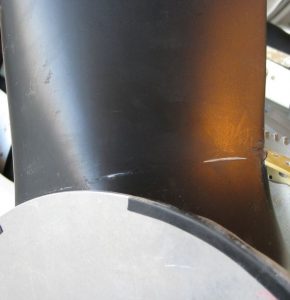Propeller cutout and resin: The template for the cutout in the spinner for the prop blades is incorrect due to the addition by SH of a 5/16″ spacer in front of the front plate. Be sure to only use the fire retardant resin (supplied with the induction option kit) in the cowling when reinforcing for the cowl flap. The cowling instructions make no mention of this.
–Glen Culver
CS Props: I called called American Propeller and talked to Paul I asked him about the specified prop for the 0-360 lycoming engine: HCF2YR-1F/F7666A-2 This is the long ” F” flange version of that prop and is about 3 inches longer than the “C” flange. It is the prop hub that is rare, not the blades. This prop specified by Stoddard-Hamilton is a long-flange prop that was used only on one aircraft, the Piper Dakota. This is what makes the hub and prop rare.
He said that he could sell every one of these prop hubs that he could get his hands on because they are popular for sleaker homebuilt cowls. Therefore there will be no big deals out there unless you are lucky. You have to work hard at this to be lucky as some one mentioned.
Another route to go is to use the C hub ( HCC2YR-1F/F7666A-2). The C hub which is much more popular (split hub measures 4.71 inches The F model hub measures 7.187. Check these numbers before you rely on them. The C model might be useable if you order a 3 inch spacer and add it to the prop. This is frequently done with wood props and I have 8 inch extensions on my Defiant. Paul referred me to to Judy Saber (954-436-9496) of Saber company. This company makes only extensions now but in the past has supplied welded assemblies for homebuilders. Cost of an extension would be approx. $273 with a $60 charge for a modification to allow for safetying of the bolts. The discussion on extensions was complex with many variations that I will not go into. The price Paul quoted me for a C model (short) hub prop was in the area of $4500 to $4700 for a prop in OH condition.
I plan to contact Hartzell prop company to check on the safety of using up to a three inch spacer on this prop.
–John Steichen #5467
Spinner-cowl alignment: I’m sure you’ve seen homebuilts at fly ins with the spinner lower than the cowl. This sagging of the engine is caused by the engine mount bushings “seating”. If you line up your spinner so it flows into the top cowl, after hours of operation, the engine will sag, dropping the spinner below the cowl. I’m sure most builders would think this is kind of un-attractive. You might consider setting the spinner 1/4″ or so above the cowl to allow for engine sag. I did this on my RV-6 and the engine did sag a bit after several hours of flight and the spinner/cowl lines look pretty good. I might even go 3/8″ on the next one. This is an area where I think it might pay to error on too much as not enough. A slightly high spinner in relation to the cowl doesn’t look as bad and one that is too low, IMO. I used Barry Control rubber engine mounts on my Dynafocal installation. I don’t know what is recommended on the Glastar. You might think that simply having the engine installed with the bolts torqued would settle things in but I didn’t find this to be the case. It takes a few hours of flight for things to settle down. The above may not be applicable if your are using the stiffer acrobatic mounts.
–Bob Skinner
Prop extensions: The difference would seem top be the extension that is built in to the prop that SH offers. In order to fit the cowling the prop needs about a three inch extension. Our solution for this was to buy a HC C2YL-1 which is used on the 160 HP Citabria. As we fit the cowling we plan to call Sabre Engineering (954 436-9496) and have them manufacture a custom extension. This should cost us about $300 according to our past conversations with Sabre. If you start down this road make sure you get the right prop governor! The B210776 (Woodward) governor uses pressure to increase pitch. The D210688 uses pressure to decrease pitch. To change from one to another you need to change the pilot valve. Not really a big job, just that the pilot valve costs about $400! BTW the Cessna Cardinal uses a McCauley prop that has a built in extension. I think it would fit just fine!
–Tom Lempicke

Spinner/prop clearance: I just changed my Sportsman spinner from the fiberglass cone to a skull cap. My spinner is odd because of fixed pitch prop so is actually a Glasair spinner.
I thought I had enough clearance, spinner to the prop but did not. Under power the spinner must shift just a wee bit. I have opened up the openings on the fiberglass spinner but decided to use a skull cap instead.
Ted Setzer had mentioned that you never want fiberglass rubbing against aluminum, here is proof that Ted was once again right. Had to have the prop serviced and they sanded out the gouge and rebalanced the prop.
–Randi Ernst



